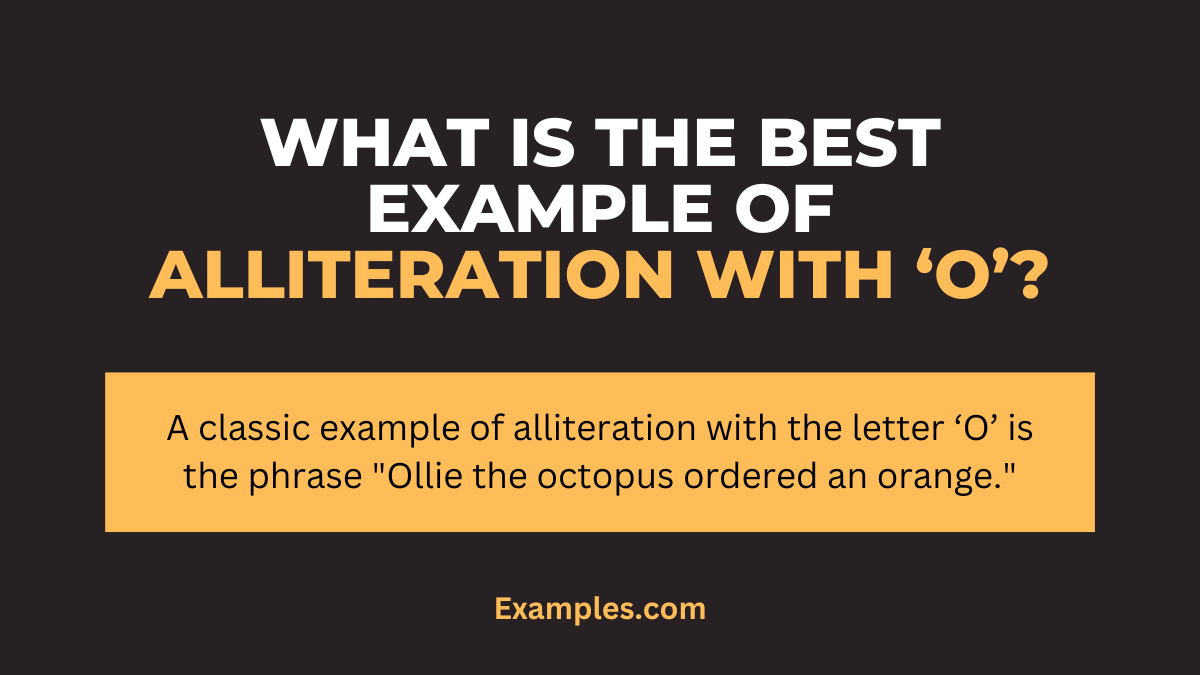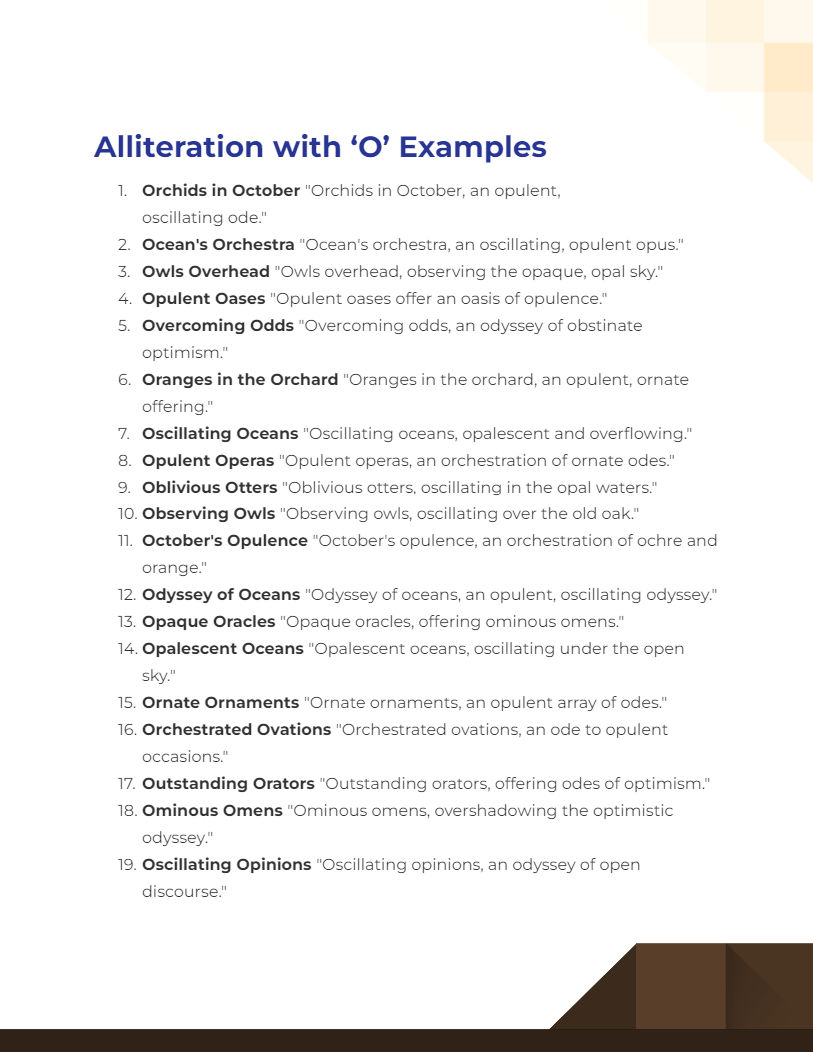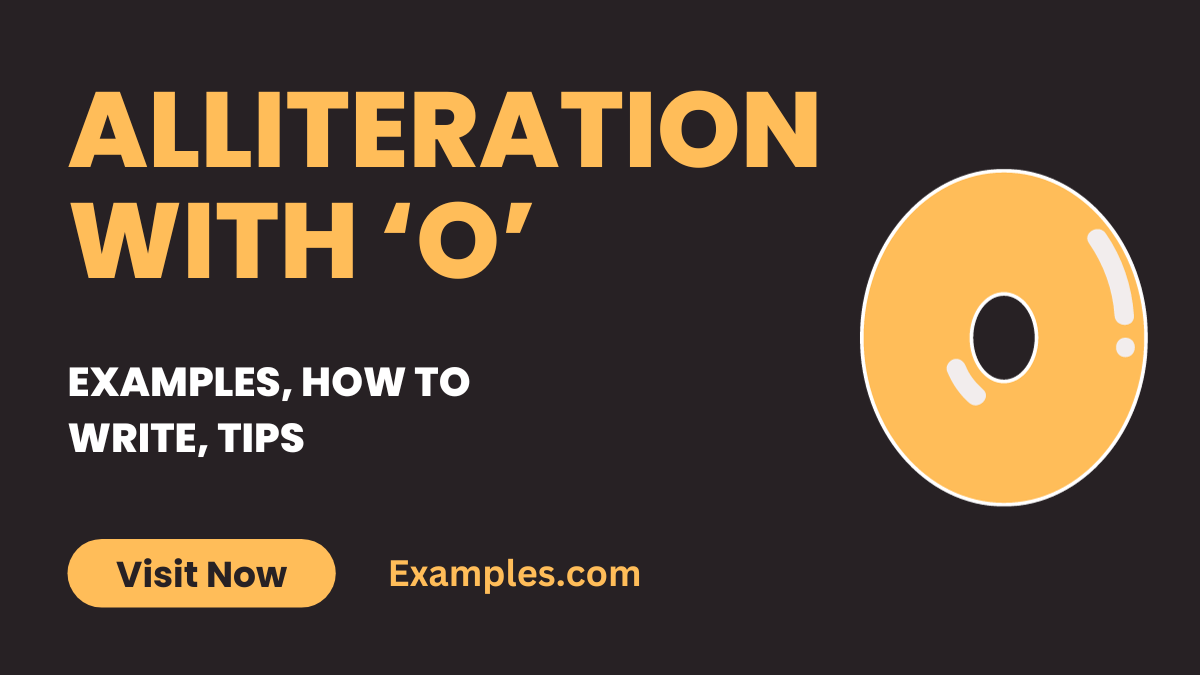19+ Alliteration with O Examples
Alliteration with the letter ‘O’ offers a unique opportunity to add a lyrical and often soothing quality to writing. This literary device, featuring the repetition of the ‘O’ sound at the beginning of neighboring words, is adept at creating a sense of flow and rhythm in text. It’s a favorite among poets and authors for its ability to produce a hypnotic effect, drawing readers into a specific mood or atmosphere. Whether used subtly or prominently, alliteration with ‘O’ can significantly enhance the auditory appeal of a phrase, making it more engaging and memorable. This technique is especially effective in evoking emotions and setting the scene, making it a valuable tool in any writer’s arsenal.
Download Alliteration with 'O' Examples
Download Alliteration with 'A' to 'Z' Examples
What is the Best Example of Alliteration with ‘O’?

Example: A classic example of alliteration with the letter ‘O’ is the phrase “Ollie the octopus ordered an orange.”
Meaning: Alliteration is a literary device where consecutive words in a sentence or phrase begin with the same consonant sound. In the example “Ollie the octopus ordered an orange,” the consonant ‘O’ is repeated at the beginning of several words, creating a rhythmic and catchy sound pattern. This technique is often used in poetry and literature to add emphasis, rhythm, and musicality to the text. In this specific example, the easy alliteration repeated ‘O’ sound makes the sentence fun and memorable, as it describes the actions of Ollie the octopus and his preference for an orange.
20 Alliteration with ‘O’ Examples

Download Alliteration with 'O' Examples in PDF
Alliteration with the letter ‘O’ offers an orchestration of opulent and oscillating sounds, opening a realm of oral elegance. The ‘O’ sound, known for its openness and often resonant quality, is suitable for crafting both easy and hard alliteration examples. Particularly in alliteration in rhymes, the ‘O’ sound adds a rhythmic and harmonious dimension to phrases, creating an enchanting effect. Here are 20 unique examples of alliteration with ‘O’, each complemented by a rhyme title that encapsulates the essence of the phrase.
- Orchids in October “Orchids in October, an opulent, oscillating ode.”
- Ocean’s Orchestra “Ocean’s orchestra, an oscillating, opulent opus.”
- Owls Overhead “Owls overhead, observing the opaque, opal sky.”
- Opulent Oases “Opulent oases offer an oasis of opulence.”
- Overcoming Odds “Overcoming odds, an odyssey of obstinate optimism.”
- Oranges in the Orchard “Oranges in the orchard, an opulent, ornate offering.”
- Oscillating Oceans “Oscillating oceans, opalescent and overflowing.”
- Opulent Operas “Opulent operas, an orchestration of ornate odes.”
- Oblivious Otters “Oblivious otters, oscillating in the opal waters.”
- Observing Owls “Observing owls, oscillating over the old oak.”
- October’s Opulence “October’s opulence, an orchestration of ochre and orange.”
- Odyssey of Oceans “Odyssey of oceans, an opulent, oscillating odyssey.”
- Opaque Oracles “Opaque oracles, offering ominous omens.”
- Opalescent Oceans “Opalescent oceans, oscillating under the open sky.”
- Ornate Ornaments “Ornate ornaments, an opulent array of odes.”
- Orchestrated Ovations “Orchestrated ovations, an ode to opulent occasions.”
- Outstanding Orators “Outstanding orators, offering odes of optimism.”
- Ominous Omens “Ominous omens, overshadowing the optimistic odyssey.”
- Oscillating Opinions “Oscillating opinions, an odyssey of open discourse.”
- Opulent Odyssey “Opulent odyssey, an oscillating, ornate odyssey.”
Alliteration Sentence Examples with ‘O’
Alliteration sentence examples with ‘O’ often exhibit an open, oscillating rhythm, bringing a distinctive oral quality to the phrases. This type of alliteration is used in various literary forms, including alliteration in poems, songs, and movies, to add depth and rhythm. Here are three examples:
- “Olivia’s orange orchids offered an oasis of calm.”
- “Oscar’s old owl observed the ominous, overcast sky.”
- “Ollie’s optimistic outlook overshadowed ordinary obstacles.”
Alliteration Examples with ‘O’ Words
Alliteration examples using ‘O’ words demonstrate the effectiveness of this vowel in creating resonant, rhythmic phrases. This form of alliteration is often utilized for its captivating quality in alliteration in songs. Here are three examples:
- “Overwhelmingly, the ocean’s waves overlapped on the shore.”
- “Ominous omens overshadowed the once optimistic oracle.”
- “Orchestrated overtures opened the opulent opera evening.”
Alliteration Poem with ‘O’
An alliteration poem with ‘O’ uses the repetitive ‘O’ sound to create a rhythmic and engaging poetic experience. Alliteration in poems, especially with the ‘O’ sound, adds a unique lyrical quality. Here are three examples:
- “Oceans of opulence, / Over valleys, under fence.”
- “Only owls in the oak, / Observing night’s velvet cloak.”
- “Orchards of oranges bright, / Offer scents in the night’s light.”
Alliteration Starting with ‘O’
Alliteration starting with ‘O’ sets a specific tone and rhythm in a phrase, creating a memorable and impactful auditory experience. Found in various artistic expressions, including alliteration in movies, it adds a distinctive element. Here are three examples:
- “Orla’s orchestra opened with an outstanding overture.”
- “Owen’s old oak overlooked the opalescent ocean.”
- “Oscar’s only option was an obscure, outlying outpost.”
Alliteration with ‘O’ for Kids
Alliteration with ‘O’ for kids involves simple, fun phrases that are easy for children to understand and enjoy. This type of alliteration can be used effectively in alliteration for kids, helping in language development. Here are three examples:
- “Ollie the octopus owns eight orange overcoats.”
- “Olly’s otters organized an outdoor obstacle course.”
- “Olive the owl often orders oatmeal for breakfast.”
How to Write Alliteration with ‘O’?
Creating alliteration with the letter ‘O’ involves using words that start with the ‘O’ sound in close proximity within sentences or phrases. The ‘O’ sound, known for its open and often resonant quality, can add rhythm and a distinctive tone to your writing. This technique is used in various contexts, from poetic compositions to educational materials like alliteration for first grade. Here’s how to craft effective alliteration with ‘O’:
- Identify the ‘O’ Sound: Understand the ‘O’ sound, which can be short as in “octopus” or long as in “ocean.” It’s a versatile sound that can be used in various contexts.
- Select a Theme or Concept: Choose a theme or subject for your sentence. This helps in finding ‘O’ words that are relevant and appropriate for your context, whether you’re creating alliteration with answers or for creative expression.
- Brainstorm ‘O’ Words: Make a list of words starting with ‘O’. Include a variety of words (nouns, verbs, adjectives) to add depth to your alliteration.
- Formulate Your Phrase or Sentence: Arrange the ‘O’ words to form a coherent and rhythmic sentence. Aim for a natural flow that emphasizes the alliterative effect.
- Read Aloud for Rhythm: The effectiveness of alliteration is best judged audibly. Read your sentence aloud to ensure it flows well and the ‘O’ sound is pronounced clearly.
- Revise for Clarity and Impact: Ensure your alliterative phrase is clear and contributes effectively to your overall message or story.
- Apply in Various Contexts: Whether it’s in alliteration figurative language exercises, as part of teaching alliteration for first grade, or in creative writing, adapt your use of ‘O’ alliteration to suit the purpose and audience.
Tips for Using Alliteration with ‘O’
Here are the Tips for Using Alliteration with ‘O’:
- Use Sparingly: While alliteration can add style and rhythm, overusing it can detract from your main message. Use it to emphasize key points or add flair in moderation.
- Maintain Clarity: Your primary goal is to convey a message clearly. Alliteration should complement, not complicate, your narrative.
- Vary Word Length and Complexity: Mix short and long ‘O’ words, as well as simple and complex words, for a more dynamic textual rhythm. This is especially important in alliteration for first grade, where simpler language is necessary.
- Consider the Mood: The ‘O’ sound can be both open and resonant. Use it in contexts where this mood is desired.
- Read and Revise: Reading your work aloud helps you assess the rhythm and flow. Adjust as needed to ensure the alliteration enhances the text.
- Appropriate for Audience: Tailor your alliteration to your audience. For example, alliteration for first grade should be simpler and more playful than alliteration for adults.
- Explore Different Forms: Try ‘O’ alliteration in various forms of writing, from poetry and stories to advertising and academic work, to understand its effect.
Remember, the key to effective alliteration with ‘O’ is balancing creativity with readability, ensuring that the alliterative phrases enhance rather than detract from your writing.
What are the Tongue Twisters that Start with ‘O’?
Tongue twisters that start with ‘O’ are phrases or sentences designed to be challenging to pronounce quickly and correctly, often involving the repetition of the ‘O’ sound. These tongue twisters are not only entertaining but also serve as a great way to practice pronunciation and improve speech clarity. They are used in various contexts, from language learning exercises for students to fun challenges of alliterative for students. Here are a few examples:
- “Oliver ogled an owl and an ocelot at the opera.”
- “Olive ordered orange orchids for October’s outdoor event.”
- “Omar observed an otter outsmarting an octopus.”
These tongue twisters can be both fun and educational, helping to improve diction and language skills.
What is the Effect of ‘O’ Letter in Alliteration?
The effect of the ‘O’ letter in alliteration is to create a round, resonant sound that can add depth and musicality to the text. The ‘O’ sound is versatile and can be used to produce a variety of tones, from deep and sonorous to light and playful. In alliteration literature, ‘O’ alliteration is often used to enhance the lyrical quality of language, making it more engaging and memorable. It can be found in great alliteration examples in both children’s literature and more complex literary works. The ‘O’ sound in alliteration is also significant in creating a rhythmic flow in poetry and prose, contributing to the overall aesthetic and auditory experience of the reader.
What is the Alliteration ‘O’ Type of?
Alliteration with the letter ‘O’ is primarily a type of vowel alliteration. This form involves the repetition of the initial vowel sound ‘O’ at the beginning of adjacent or closely connected words. Vowel alliteration, including the ‘O’ type, typically provides a softer, more melodious effect compared to consonantal alliteration. It’s a popular literary device used across various genres and forms of writing. ‘O’ alliteration can be found in a wide range of contexts, from educational materials like alliteration for students to more sophisticated literary compositions for adults. It is often used in conjunction with alliteration and assonance exercises to explore the sonic qualities of language. The ‘O’ type of alliteration is valued for its ability to add a lyrical quality to writing, enhancing its rhythm and musicality.


